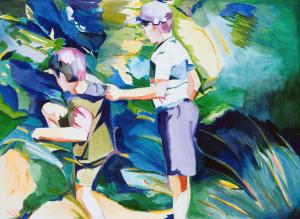Looking for design inspiration? Browse our curated collections!
August 5th, 2015 - 12:15 PM

The Basics of Watercolour Painting
This blog is dedicated to the art of watercolour painting. I've written a brief of how I work in the medium and added recommendations for the supplies that have made watercolour painting a joy.
The Watercolour Painting
The primary fallacy of watercolour painting is that it is a spontaneous medium. It is nothing of the sort. This medium requires accuracy and forethought and controlled flow.
I usually work from photo shoots and select the best from sometimes 2-3 rolls of film or from innumerable digital exposures.
The drawing is applied utilizing a 4 point grid and for portraiture sometimes an 8 point grid. The drawing is done with precision and I am aware throughout the process of the tonal values. I enjoy working from black and white photos so I don't 'match' the colour, but allow it to spring from me. Colour is really an intrinsic happening.
Please note that 80% of the painting is founded in the drawing. I begin with blocking in general forms and then work tighter and tighter until the image is complete. If it is a portrait I will continually check for accuracy with a mirror. Mistakes are easily viewed from the mirror image. I work from general washes and get tighter and tighter as the work progresses, laying the pigment to bring it to the correct tonal value.
One vital mention is not to overload the brushes with water nor to forget to have clean water, especially when working with darker tones.
And then there is the wet on wet look that everyone adores-the key to this is to control the water! Yes, it takes practice, but remember
it's better to have less water than more otherwise the common complaint is 'muddy'.
The Supplies of Watercolour
Paper
Archer's 300 lb. cold press paper (22- X 28-).
A 300 lb sheet will not bend and takes an incredible beating. It allows one to work the watercolour without any concern of warping. The only drawback is that in high humidity this paper has a peculiar odor.
Cold press paper is poured into molds that create crevices and this allows for layering of watercolour.
This paper is pricey, but well worth its weight. It may be purchased in packets, containing 5 and is cheaper than buying individually.
**Mixed Media -watercolour/pastel
If creating a mixed media painting as with pastel added to watercolour, the crevices of 300lb cp paper allows the pastel to be imbedded.
For primary undercoat, watercolour is a quick and translucent media for working with the rich, but dry texture of pastel.
**Mistakes
Archer's 300 lb allows one to take a boar's bristle brush, with water to scrub out the error and work with watercolour without disturbing the surface.
Watercolour
I recommend Daler-Rowney watercolour. Daler-Rowney Ltd. is a British company that has been in business since 1783. It began as a perfume company, but quickly moved into the art business.
Windsor & Newton also is a company one can rely on for radiant filled paints.
Professional versus Student watercolour
The obvious difference when at the cash register is the price. But what is the variant? It's in the pigments. The student watercolour has less pigment and more fill. The primary additive to watercolur is gum arabic.
The professional watercolour will last forever as the paint to water ratio is very low.
Pan versus tube watercolour
The difference between is personal preference. I prefer the pan as I don't need to concern myself with making sure the tube is closed. During working sessions, I can walk away anytime with no concern about clean up. Sometimes I even dip one colour right into another without the usage of my white porcelain tray. Is it laziness or just enthusiastic painting? I like to think it's the later.
Brushes
The Kolinksy Sable
These brushes are the Mercedes of watercolour brushes. Sable brushes can soar to $500.00 each and more. Sable brushes are taken from the Kolinsky weasel and found in Siberia. They are harvested au natural and difficult to find. The brushes are a deep red and are available in round or flat and in varying thickness.
Synthetic Brushes
These brushes also do the job. The drawback is that sometimes they drop out or fray just when you need them to stay put and to have a sharp point for fine detail work.
Bristle Brushes
Although not part of the norm repertoire for watercolour painting, I have utilized these firm and sturdy brushes for spreading the water in large areas.
Water
There are many natural spring waters originating from all over the nation and world. Choose wisely as the water is a key element to the outcome of the painting! Really now, just turn the tap and let it flow!
Highlight or delete this text and replace with your own....Highlight this text and replace with your own.... Highlight this text and replace with your own....and please remember that art transforms lives.
Comments
There are no comments on this blog. Click here to post the first comment.